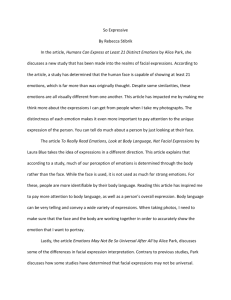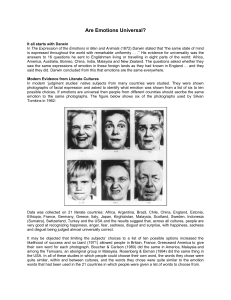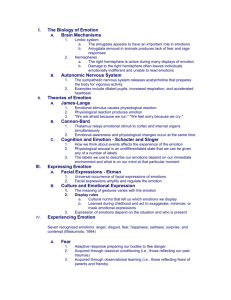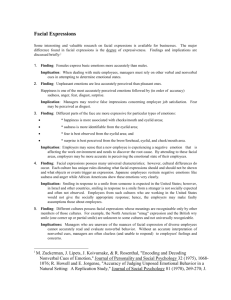Recognizing Emotions in Facial Expressions
advertisement
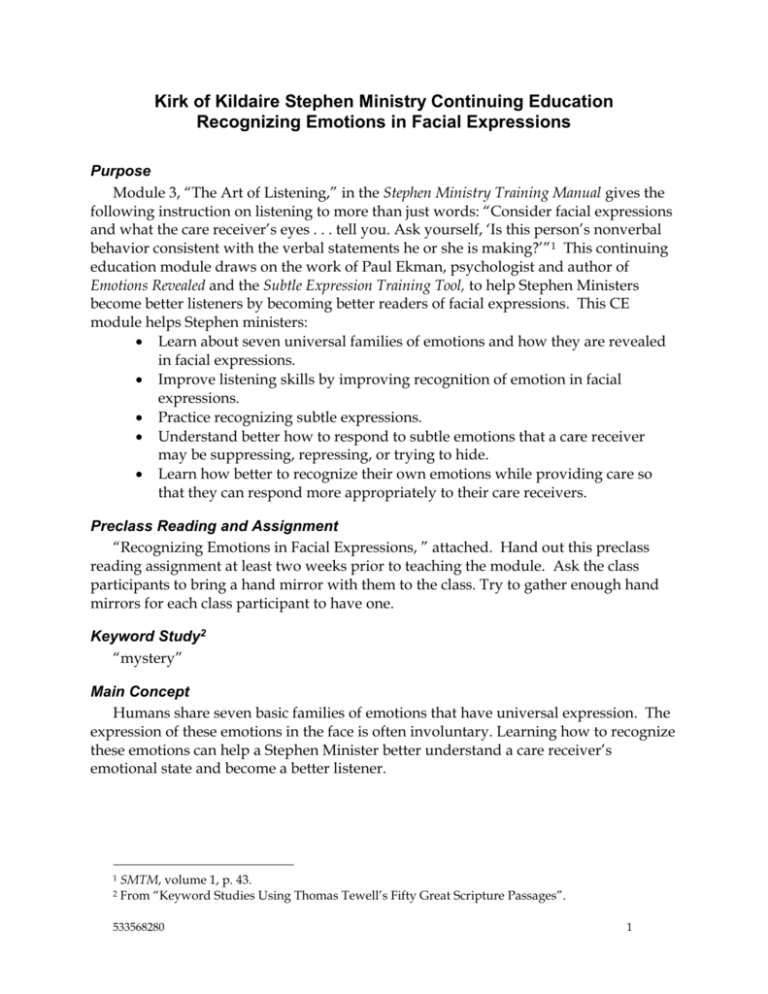
Kirk of Kildaire Stephen Ministry Continuing Education Recognizing Emotions in Facial Expressions Purpose Module 3, “The Art of Listening,” in the Stephen Ministry Training Manual gives the following instruction on listening to more than just words: “Consider facial expressions and what the care receiver’s eyes . . . tell you. Ask yourself, ‘Is this person’s nonverbal behavior consistent with the verbal statements he or she is making?’”1 This continuing education module draws on the work of Paul Ekman, psychologist and author of Emotions Revealed and the Subtle Expression Training Tool, to help Stephen Ministers become better listeners by becoming better readers of facial expressions. This CE module helps Stephen ministers: Learn about seven universal families of emotions and how they are revealed in facial expressions. Improve listening skills by improving recognition of emotion in facial expressions. Practice recognizing subtle expressions. Understand better how to respond to subtle emotions that a care receiver may be suppressing, repressing, or trying to hide. Learn how better to recognize their own emotions while providing care so that they can respond more appropriately to their care receivers. Preclass Reading and Assignment “Recognizing Emotions in Facial Expressions, ” attached. Hand out this preclass reading assignment at least two weeks prior to teaching the module. Ask the class participants to bring a hand mirror with them to the class. Try to gather enough hand mirrors for each class participant to have one. Keyword Study2 “mystery” Main Concept Humans share seven basic families of emotions that have universal expression. The expression of these emotions in the face is often involuntary. Learning how to recognize these emotions can help a Stephen Minister better understand a care receiver’s emotional state and become a better listener. 1 2 SMTM, volume 1, p. 43. From “Keyword Studies Using Thomas Tewell’s Fifty Great Scripture Passages”. 533568280 1 Supplies Needed Emotions Revealed, by Paul Ekman (New York: Henry Holt and Company, 2003). It is best if you read this book in its entirety before teaching this module. Subtle Expression Training Tool (CD-ROM), by Paul Ekman, 2003. Available from www.emotionsrevealed.com. A computer running Microsoft Windows. A multimedia projector. Copies of handouts for each class member. Copies of preclass reading for each class member. Hand mirrors for each class member (you might ask class members to bring their own). Time Needed One hour. Procedure I. Introduction and Pretest (20 minutes) A. Introduction Listen to the story Nehemiah tells of gaining permission from King Artaxerxes for rebuilding Jerusalem: 1 In the month of Nisan, in the twentieth year of King Artaxerxes, when wine was served him, I carried the wine and gave it to the king. Now, I had never been sad in his presence before. 2 So the king said to me, "Why is your face sad, since you are not sick? This can only be sadness of the heart." Then I was very much afraid. 3 I said to the king, "May the king live forever! Why should my face not be sad, when the city, the place of my ancestors' graves, lies waste, and its gates have been destroyed by fire?" 4 Then the king said to me, "What do you request?" So I prayed to the God of heaven. 5 Then I said to the king, "If it pleases the king, and if your servant has found favor with you, I ask that you send me to Judah, to the city of my ancestors' graves, so that I may rebuild it." (Nehemiah 2:1-5) Like Nehemiah in this story, we often wear our emotions on our faces. Sometimes those emotions are written largely on our faces, like when a child comes home from school with exciting news, or when you greet a dear friend you have not seen for a long time. But other times, as was the case of Nehemiah in the story we just read, we try to conceal the emotions we are feeling by controlling our facial expressions. But even then, also like Nehemiah, our faces betray what we are hesitant or afraid or unready to share. Often when we are trying to control the emotion in our faces, or when an emotion is just beginning to well up inside us and we are not yet aware of it, our faces show just a subtle hint of the emotion. This is what we are going to be talking about tonight: the subtle hints of emotions that 533568280 2 you might detect in your care receivers’ faces. Learning to detect subtle emotions in facial expressions can help make us better listeners. B. In tonight’s CE module, you will learn how better to recognize the subtle facial expressions of seven universal emotions: sadness, anger, fear, surprise, disgust, contempt, and pleasure. These are emotions that have been found to exist in many geographical and cultural contexts and to be expressed in the face nearly identically everywhere they are found. Before we talk specifically about emotions and facial expressions, let’s see how well you already know how to recognize them. I’m going to show you a random series of 37 emotional expressions and I want you to identify them on the sheet labeled, “Pretest Score Sheet.” (Show participants the score sheet.) Each picture is numbered down the first column and the emotions are labeled across the top row. When you see a facial expression, I’ll give you a second to check off which one you think it is. Then I’ll select an answer and you’ll see the correct answer displayed on the right side of the screen. Use the last two columns to indicate whether you got the correct answer. I’m going to show you a few expressions just so you can see how this program works. Then I’ll start it over and you can start marking your score sheet. Start the Subtle Expression Training Tool with the speed of the expressions set at 5. Show just a few expressions, then restart the tool so that participants can mark their sheets. II. When the test is complete, ask participants to share their results. Show them how to score their tests using the “Scoring Your Test” sheet. What was surprising? Was it more difficult or easier than they had expected? Which emotions are similar in their expression? Which are hardest to detect and which are easiest? Recognizing Emotions in Facial Expressions (15 minutes) A. Introduction B. 533568280 In your preclass reading you learned about how the seven emotions are expressed in people’s faces. I want to talk in greater depth about three of those that you are likely to encounter in your care receivers: sadness, anger, and pleasure. The way I want to talk about them is to do some exercises to evoke these emotions and then we will talk about what you have seen and felt so that you can learn to better recognize what you see in your care receivers’ faces. You will need your hand mirrors to do these exercises. Sadness 3 1. Definition 2. The emotions triggered by loss: sadness, agony, distress, disappointment, dejection, blues, depression, discouragement, despair, grief, helplessness, misery, sorrow. Some of the more intense forms of sadness—agony, distress, and misery—involve an element of protest. Others involve more resignation and hopelessness. Responding 3. The purpose of sadness is to call out for help, to impose one’s suffering on others so that they will help, to signal a need for comfort. Being with someone who is sad may trigger empathic feelings, which is how we establish bonds with others. This capacity to feel what another person is feeling is sometimes called “limbic resonance” and it is a physiological and psychological capability that is unique to mammals. 3 Our brains are capable of sensing what another person is feeling and aligning our feelings with the other person. We are particularly good at aligning ourselves with people’s sadness. That is one of the functions of sadness: to evoke empathy and get help. Evoking Let’s see if we can become more in tune with the physiology and facial expression of sadness by invoking it in ourselves. As you do this exercise it will be helpful to check your facial expression in a mirror. Also, try to tune in to your internal physiological sensations. What does your body feel like as you evoke sadness in yourself. 4. 3 Try this exercise: (Read the instructions for the exercise on page 94 of Emotions Revealed.) Ask the participants what changes they felt in their bodies or saw in their faces as they did this exercise. Some answers they might give are: Physiology Eyelids become heavy Cheeks rise Back of throat becomes sore Eyes moisten with tears Expression Inner corners of eyebrows angle upwards Neenah Ellis, If I Live to be 100 (New York: Crown Publishers, 2002), pp. 184-190. 533568280 4 C. Anger 1. Definition 2. The emotions triggered by interference, frustration, attack, disappointment, offensiveness. Anger comes in abroad range of intensity: annoyance, sulking, indignation, exasperation, vengeance, rage. Responding 3. Anger’s purpose is usually to control, punish, or retaliate; to remove the person or thing that is interfering. It often evokes anger in response and, because of this cycle of mutual retaliation, is one of the most dangerous emotions. But it can also help us to understand when we need to change what we are doing or change the situation that is making us angry. Before responding to anger it is very important to understand what is causing the anger, particularly since some of the facial expression of anger are identical to expressions of difficulty or intense concentration. Evoking 4. 533568280 In some people, eyebrows do not angle upwards, but produce a horseshoe shape between the brows, called the “grief muscle.”* Upper eyelids droop; lower lids tense Eyes gaze down Vertical wrinkle between eyebrows Cheeks pulled up; sometimes so strongly that the lips seem to be smiling Lips stretch horizontally; lower lip pushes up; corners push down Chin boss wrinkled Try this exercise: (Read the instructions for the exercise on page 134 of Emotions Revealed.) Ask the participants what changes they felt in their bodies or saw in their faces as they did this exercise. Some answers they might give are: Physiology Increased sensation of pressure, tension, and heat Heart rate and respiration increase Blood pressure rises Face reddens Teeth clench Jaw thrusts forward 5 Impulse to move forward Recognizing Brows lower and draw together Lower lids tighten Upper lids raise Eyes glare Jaw clenched or thrust forward Teeth exposed Lips either open in a square or rectangular shape or pressed tightly together Red margin of lips becomes thinner, narrower* Lower lip pushed up D. Pleasure 1. Definition The emotions triggered by pleasurable experiences: joy, enjoyment, happiness, contentment, amusement, excitement, relief, wonder, admiration, ecstasy, bliss, rapture, fiero (an Italian word for basking in accomplishment), natches (a Yiddish word for the glow of pleasure-plus-pride), elevation, uplifted, gratitude, love 2. Responding 3. 4. 533568280 In a caring relationship, one of the most important distinctions you may have to make is between a polite smile and an enjoyment smile. It is rare that a person can voluntarily contract the muscles surrounding the eyes in a smile of true enjoyment. Learning to distinguish a polite smile from an enjoyment smile can give you insight into your care receiver’s emotions. Evoking Try this exercise: (Read the story of Rindercella (attached) to help the participants achieve a true enjoyment, or Duchenne smile.) Ask the participants what changes they felt in their bodies or saw in their faces as they did this exercise. Some answers they might give are: Physiology Goose bumps Tingling in shoulders and back Laughter Smiling Recognizing Smile: Not every smile is equal: 6 Social or polite smiles engage only the zygomatic major muscle, running from the cheekbones to the corner of the lips and pulling them up into a smile. Duchenne or enjoyment smiles also engage two groups of muscles circling the eyes.* Voice: Voice distinguishes one enjoyable emotion from another. Four distinct pleasurable emotions can be perceived in voices: Contentment Relief Sensory pleasure involving touch Fiero Skill Practice (15 minutes) A. Exercise (10 minutes) 1. Ask the participants to gather in pairs. 2. Take turns telling the stories you were asked to recall in the preclass reading. 3. As you listen to your partner, take note of the emotions you see revealed in their facial expressions. 4. You’ll have 10 minutes for this exercise. I’ll let you know when five minutes are up and then it will be time to switch story tellers and observers, it you haven’t already B. Discussion (5 minutes) 1. As you were listening to a story, what signs of emotions did you notice that you might not have noticed before? 2. As you were telling you story, were you aware of the physical sensations of emotion or the expression of it in your face? Follow-up test and discussion (10 minutes) Closing Prayer (1 minute) III. IV. V. Source This continuing education unit was prepared for Stephen Ministers at Kirk of Kildaire Presbyterian, Cary, NC. Contact Susan Mazzara at susanmazzara@hotmail.com or 919-387-0920 if you have questions. 533568280 7 Rindercella This delightful Spoonerism was reportedly written by Mr. Archie Campbell of "Hee Haw'' fame. What's a Sponerism? It's a phrase or sentence with an accidental interchange of the initial sounds of words. Example: "A well-boiled icicle" for "a well-oiled bicycle." Spoonerisms get their name from Rev. W. A. Spooner (1844-1930) who was noted for making such slips of the tongue. Rindercella (Cinderella) Tunce upon a whine, in a coreign fountry, there lived a geautiful birl and her name was Rindercella. Rindercella lived with her mugly other and her two sad blisters. Also, in this same coreign fountry, there lived a very prandsome hince. Now, this prandsome hince was going to have a bancy fall, so he invited all the people for riles amound, 533568280 8 especially the pich reople. So, Rindercella's mugly other and her two sigly usters went out to get some dancy fresses to wear to the bancy fall. But, Rindercella couldn't go because all she had to wear was some old rirty dags. So, she just cat down and sried. Well she was kitten there srying, and all of the sudden, there appeared before her, her gairy mudfather. And she waved her wagic mand and there appeared before her a kig boach and hix white sorses to take Rindercella to the bancy fall! ''But,'' she warned her, ''you be home before nidmight or I'll purn you into a tumpkin.'' So, Rindercella went to the bancy fall and she was det at the moor by the prandsome hince, because he had been 533568280 9 watching from behind a widden hindow. And, as soon as they met, they lell in fove! And, nanced all dight, until nidmight. Then, the stock clucked nidmight, and Rindercella staced down the rairs. And, just as she beached the rottom, she slopped her dripper! Well, the next day, the prandsome hince went all over the coreign fountry looking for the geautiful birl who had slopped her dripper. He came to Rindercella's house and tried it on her mugly other, and it fidn't dit. He tried it on her two sigly usters, and it fidn't dit. Then he tried it on Rindercella and it fid dit. So, they were married and lived heavily ever hapwards. 533568280 10 Now, the storal to this mory is: If you ever go to a bancy fall and want to have a prandsome hince lall in fove with you, don't forget to slop your dripper. 533568280 11 Pretest Score Sheet Sadness Anger Surprise Fear Disgust Contempt Happy Right Wrong 1 2 3 4 5 6 7 8 9 10 11 12 13 14 15 16 17 18 19 20 21 22 23 24 25 26 27 28 29 30 31 32 33 34 35 36 37 Totals 533568280 12 Follow-up Score Sheet Sadness Anger Surprise Fear Disgust Contempt Happy Right Wrong 1 2 3 4 5 6 7 8 9 10 11 12 13 14 15 16 17 18 19 20 21 22 23 24 25 26 27 28 29 30 31 32 33 34 35 36 37 Totals 533568280 13 Scoring Your Test If you answered correctly 37 36 35 34 33 32 31 30 29 28 27 26 25 24 23 22 21 20 19 18 17 16 15 14 13 12 11 10 9 8 7 6 5 4 3 2 1 533568280 Your score is 100% 97% 95% 92% 89% 86% 84% 81% 78% 76% 73% 70% 68% 65% 62% 59% 57% 54% 51% 49% 46% 43% 41% 39% 35% 32% 30% 27% 24% 22% 19% 16% 14% 11% 8% 5% 3% 14 Recognizing Emotions in Facial Expressions Preclass Reading Stephen Ministry and the Art of Listening We listen to people every day: to our children or spouses as they relate the stories of their days, to service workers as they describe a repair they have just made, to newscasters on TV or radio, to doctors and nurses as they explain a course of treatment, to teachers as they introduce a new concept. Our ordinary, everyday listening comes to us naturally and without much special thought. The listening we do as Stephen Ministers, however, is different. In our caring relationships we learn to listen to more than just words. We also “listen” to body language, gestures, and facial expressions. In “The Art of Listening,” module 3 in the Stephen Ministry Training Manual, we read: Good listeners seek to understand as completely as possible how the speaker views or relates to his or her world. They read between the lines of another’s communication and observe the other’s body language. Pay attention to voice tremors, gestures, rate and type of breathing . . ., color . . ., muscle tension . . ., posture . . ., and choice of clothing. Consider facial expressions and what the care receiver’s eyes tell you (tearful, focused away from you during conversation, closed). Ask yourself: “Is this person’s nonverbal behavior consistent with the verbal statements he or she is making?” (SMTM, 43) This continuing education unit will give you information and practice to help you listen more closely to facial expressions. As Stephen Ministers, we are particularly attuned to and concerned with the emotional lives of our care receivers. We listen, in part, so that we can help our care receivers recognize and express their emotional responses to the events of their lives. Learning to recognize how emotions are manifest in facial expressions can improve your listening skills and help you provide the best possible distinctively Christian care. Seven Universal Emotions Dr. Paul Ekman, professor of psychology at the University of California Medical School in San Francisco, has identified seven universal families of emotions, each of which can be identified by distinctive facial expressions: sadness, anger, surprise, fear, disgust, contempt, and pleasure. These emotions and the facial expressions that distinguish them are cross-cultural. They occur in many cultural contexts across many geographies (Ekman, xx). Some of these seven emotions can and will occur during caring visits with your care receiver. Sometimes, however, particularly at the beginning of a caring relationship, a care receiver may not be prepared to fully reveal to you his or her internal emotional life. Your care receiver may greet you with a broad smile, for example, but lack the “smiling eyes” that signal true enjoyment. You may notice a slight tensing of the brow or eyes when your care receiver is speaking about his or her relationship with a spouse or child. You care receiver’s eyes may widen slightly as he or she describes an 533568280 15 upcoming medical procedure. Each of these gestures, however slight, is a signal for a particular emotion. By learning to recognize even subtle or partial expressions, you can strengthen your understanding of your care receiver’s emotional state. Responding to Subtle or Partial Expressions Learning to recognize subtle expressions of emotion calls for particular care in a couple of areas: understanding the cause of an emotion and having access to information your care receiver has not chosen to disclose. Do not assume to know the cause of an emotion. Emotional expressions tell us nothing about their cause. It is especially important in a caring situation—when your care receiver may be recounting a past experience that generated an emotion—that you not assume you know the cause of the emotion. (Ekman, 169) When a facial expression is subtle, you need to determine whether it signals a slight or just-beginning emotion or an emotion that a care receiver is trying to control or conceal. Acknowledging the emotion in the first case can be a liberating and affirming experience for a care receiver. A subtle expression may be an opportunity for you to encourage a fuller expression of emotion. A care receiver who is experiencing a prolonged period of grief, for example, may have learned to control its expression in the presence of friends and family who have grown impatient with his or her grief. Your encouragement could provide the permission your care receiver needs to express the grief fully and openly, and begin to heal. But in the second case, acknowledging an emotion can be a breach of trust or boundaries, for you are taking from the person information that he or she has chosen to withhold. In this case, a subtle expression may signal that the care receiver is not yet ready to share the intensity of his or her emotions with you and needs more time to build trust in the relationship before you acknowledge the emotion you see expressed. Having information about how your care receiver feels doesn’t grant you the right to tell your care receiver that you know what he or she is feeling. That right comes only when your caring relationship has progressed to a point of trust and open sharing of feelings. It is important and helpful for you to recognize and understand what your care receiver is feeling, however, even if he or she is not yet ready to fully express the feeling in your presence. (Ekman, 106-109) Learning to Recognize Subtle Expressions The table beginning on page 18 summarizes the seven families of emotions. It defines them, describes the internal physiological changes we experience when we feel an emotion, describes the external facial expressions that signal an emotion, and explains the purpose of the emotion and the type of response it is meant to elicit.4 In many caring situations—perhaps when a care receive is trying to control his or her emotions—you may receive only one or two of the facial cues that a particular emotion is being felt. A care receiver who is sad, for example, may raise the inner corners of her eyelids, but attempt to keep the rest of her face neutral. In a broad sense, when the emotion is fully expressed in the face. Subtle or partial expressions are often exhibited when the person feeling the emotion is trying not to elicit a response from others. 4 533568280 16 In other situations, people can express widely differing emotions in different parts of their face simultaneously. Raised inner corners of the eyebrows (an expression of sadness) and a broad smile (an expression of happiness) can signal bittersweet emotions. A pronounced pout (an expression of sadness) on an otherwise neutral face is often a signal of intense concentration. Understanding which facial expressions signal which emotions can help you better understand your care receiver’s emotional life. Preparing for the Class To prepare for the skill practice that we will do in class, recall a time or event when you felt a strong emotion: sadness, anger, surprise, fear, contempt, disgust, or pleasure. Recall one that you do not mind sharing with a partner in class. Review the events or situation that evoked your emotion and be prepared to tell the story to a partner. References Ekman, Paul. Emotions Revealed (New York: Henry Holt and Company, 2003). Stephen Ministry Training Manual Volume 1 (St. Louis: Stephen Ministries, 2000). 533568280 17 Summary of Families of Emotions5 Family Definition Physiology Recognizing * Denotes involuntary facial movements that cannot be deliberately fabricated. Sadness The emotions triggered Eyelids become Inner corners of by loss: sadness, agony, heavy eyebrows angle distress, disappointment, Cheeks rise upwards* dejection, blues, Back of throat In some people, depression, becomes sore eyebrows do not discouragement, despair, Eyes moisten with angle upwards, but grief, helplessness, tears produce a horseshoe misery, sorrow. Some of shape between the the more intense forms brows, called the of sadness—agony, “grief muscle.”* distress, and misery— Upper eyelids droop; involve an element of lower lids tense protest. Others involve Eyes gaze down more resignation and Vertical wrinkle hopelessness. between eyebrows Cheeks pulled up; sometimes so strongly that the lips seem to be smiling Lips stretch horizontally; lower lip pushes up; corners push down Chin boss wrinkled 5 Summarized from Ekman, chapters 5-9, pp. 82-212. 533568280 18 Responding Their purpose is to call out for help, to impose one’s suffering on others so that they will help, to signal a need for comfort. Being with someone who is sad may trigger empathic feelings, which is how we establish bonds with others. Family Definition Physiology Recognizing * Denotes involuntary facial movements that cannot be deliberately fabricated. Anger The emotions triggered Increased sensation Brows lower and by interference, of pressure, tension, draw together frustration, attack, and heat Lower lids tighten disappointment, Heart rate and Upper lids raise offensiveness. Anger respiration increase Eyes glare comes in abroad range of Blood pressure rises Jaw clenched or intensity: annoyance, Face reddens thrust forward sulking, indignation, Teeth clench Teeth exposed exasperation, vengeance, Jaw thrusts forward Lips either open in a rage. Impulse to move square or rectangular forward shape or pressed tightly together Red margin of lips becomes thinner, narrower* Lower lip pushed up 533568280 19 Responding Anger’s purpose is usually to control, punish, or retaliate; to remove the person or thing that is interfering. It often evokes anger in response and, because of this cycle of mutual retaliation, is one of the most dangerous emotions. But it can also help us to understand when we need to change what we are doing or change the situation that is making us angry. Before responding to anger it is very important to understand what is causing the anger, particularly since some of the facial expression of anger are identical to expressions of difficulty or intense concentration. Family Definition Physiology Recognizing * Denotes involuntary facial movements that cannot be deliberately fabricated. Surprise The briefest of all [Because surprise is such Eyes open wide emotions. It is triggered a short-lived emotion, it Eyebrows raised by a sudden, unexpected has few internal Jaw drops event and can be closely physiological cues that followed by fear, we can be attuned to. It amusement, relief, anger, is interesting, however, disgust, and so forth, to note the differences depending on what between surprise (an surprised us. emotion) and startle (a physical reflex): When startled, a person’s eyes squeeze shut, brows lower, lips stretch tensely. Other differences include duration (startle is even briefer than surprise), foreknowledge (knowing you are about to be startled reduces, but does not eliminate the reflex), and inability to inhibit startle.] 533568280 20 Responding (Surprise is usually such a brief emotion that there is not time to respond; instead, we respond to the emotion that follows surprise.) Family Definition Physiology Recognizing * Denotes involuntary facial movements that cannot be deliberately fabricated. Fear The emotions triggered Some physiological Upper eyelids raised by the threat (or manifestations of fear are Tensed lower eyelids perceived threat) of universals to all types of Eyebrows raised and physical or fear: drawn together psychological harm: Increased heart rate Lips stretched anxiety, worry, panic, Shortness of breath horizontally terror. Hands grow cold Chin pulled back Sweating Trembling Others differ according to whether the threat is immediate or impending. Immediate: Freeze or flight (the heart pumps blood to our leg muscles, preparing us to flee) Focus on dealing with the immediate threat Analgesic effect Impending: Muscle tension Increased vigilance Increased pain 533568280 21 Responding The purpose of fear is to protect ourselves or to cope with an immediate threat. It is easy to offer help when a fear is well grounded. It requires a well-developed capacity for compassion, however, to respond respectfully and sympathetically to someone who is experiencing groundless fear. Family Definition Physiology Recognizing * Denotes involuntary facial movements that cannot be deliberately fabricated. Disgust The emotions triggered Nausea Upper lip raised by an aversion to Gagging Lower lip raised and something or someone: Increased nasal protruding revulsion, distaste. Often sensitivity Creases between the aversion involves the nostrils and lips senses: taste, smell, sight, deepen touch, or sound, but it Nostrils flare can also by triggered by Bridge of nose actions, appearance, or wrinkles ideas. Cheeks rise and eyebrows lower, creating crow’s feet wrinkles Contempt 533568280 The emotions triggered by aversion to people or their actions (but not to tastes, smells, touch, and so on): disdain, superiority, smugness. Physiological manifestations of contempt are hard to identify, but may include: Impulse to raise your chin Tightening in one corner of your lips One lip corner raised Nose wrinkled Eyebrows lowered and pulled together 22 Responding The purpose of disgust is defensive: it helps us to avoid what can be harmful to us. Intimacy can lower our threshold of disgust, which makes it possible for parents to change diapers and clean up after sick children. In a caring relationship, it might be more important to learn how to recognize and control your own emotions when a care receiver has habits or customs that are disgusting to you. The purpose of contempt is to signal superiority or an unwillingness to accommodate or engage, or to assert power or status. Family Definition Physiology Recognizing * Denotes involuntary facial movements that cannot be deliberately fabricated. Pleasure The emotions triggered Goose bumps Smile: by pleasurable Tingling in shoulders Not every smile is experiences: joy, and back equal: enjoyment, happiness, Laughter Social or polite smiles contentment, Smiling engage only the amusement, excitement, zygomatic major relief, wonder, muscle, running from admiration, ecstasy, the cheekbones to the bliss, rapture, fiero (an corner of the lips and Italian word for basking pulling them up into in accomplishment), a smile. natches (a Yiddish word Duchenne or for the glow of pleasureenjoyment smiles plus-pride), elevation, also engage two uplifted, gratitude, love groups of muscles circling the eyes.* Voice: Voice distinguishes one enjoyable emotion from another. Four distinct pleasurable emotions can be perceived in voices: Contentment Relief Sensory pleasure involving touch Fiero 533568280 23 Responding In a caring relationship, one of the most important distinctions you may have to make is between a polite smile and an enjoyment smile. It is rare that a person can voluntarily contract the muscles surrounding the eyes in a smile of true enjoyment. Learning to distinguish a polite smile from an enjoyment smile can give you insight into your care receiver’s emotions.


